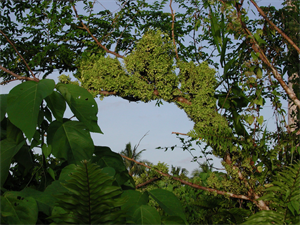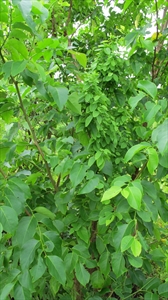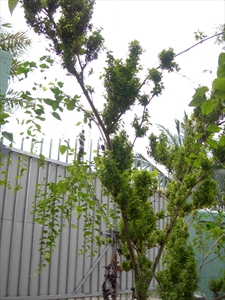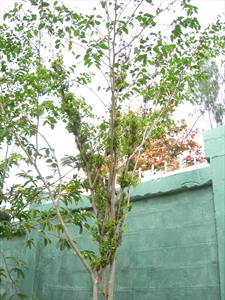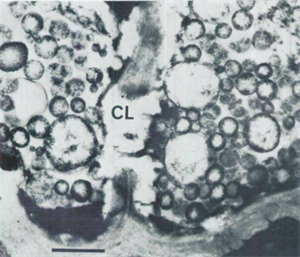Breynia bunch
Pacific Pests, Pathogens, Weeds & Pesticides - Online edition
Pacific Pests, Pathogens, Weeds & Pesticides
Breynia bunch (478)
Breynia bunch phytoplasma disease.
Recorded from Malaita and Guadalcanal, Solomon Islands.
Breynia cernua. The disease is only recorded on Breynia cernua, although other Breynia species are reported from Solomon Islands. Breynia cernua is a tree native to the Philippines, Indonesia, the southwest Pacific islands and the Northern Territory of Australia. Breynia species are members of the Euphorbiaceae family.
A serious disease associated with phytoplasma seen using the electron microscope. Phytoplasmas were previously called mycoplasma-like organisms, or MLOs. They are obligate bacteria, single celled organisms that only grow in the phloem cells of plants. Phytoplasma do not have rigid walls like bacteria. They reproduce asexually by budding.
Affected trees produce flushes of diseased growth (bunches) with short internodes, small leaves and many side (axillary) shoots (Photos 1&2). The bunches occur at the ends of established shoots or as short offshoots along the main branches (Photos 3&4).
At first, bunching occurs on one or more of the lower (older) branches, while the foliage above and on other branches remains healthy. Gradually, symptoms appear on all branches throughout the tree, and there is loss of leaves on initially healthy and bunched growth (Photo 5). Eventually, dieback and death occurs. No trees have been seen to recover or produce fresh foliage.
Phytoplasmas (Photo 6) are spread by phloem-feeding insects, leafhoppers, planthopper and psyllids. However, no candidates that might spread Breynia bunch have been identified.
The disease is of little or no economic importance. Although the tree has wood that is hard, it is not used commercially; however, some Breynia species have variegated and attractive leaves and are used as garden ornamentals.
Look for shoots with small leaves and side-shoot development giving a 'bunchy' appearance of foliage along the branches. Look for dieback and early death of the trees.
CULTURAL CONTROL
There is no information on the rate of spread of the disease, but in north Malaita and also in Honiara where the disease is common, it is likely to be rapid. In these places, removal of trees once they show symptoms may be an approach worth trying.
CHEMICAL CONTROL
Injection or foliar sprays of tetracycline may bring about a return to healthy growth (remission of symptoms), but would likely only be considered if the tree were of exceptional value, e.g., it were an ornamental. Treatment would need to be repeated and costly.
It can be assumed that an insect is spreading the disease, possibly a leafhopper, planthopper or psyllid. Therefore, to prevent spread before removing the tree or trees, spray with an insecticide. An appropriate choice would be pyrethrum or a synthetic pyrethroid.
____________________
When using a pesticide, always wear protective clothing and follow the instructions on the product label, such as dosage, timing of application, and pre-harvest interval. Recommendations will vary with the crop and system of cultivation. Expert advice on the most appropriate pesticides to use should always be sought from local agricultural authorities.
AUTHOR Grahame Jackson
Information (and Photo 6) from Dabek AJ, Jackson GVH (1977) Association of mycoplasma-like organisms with Breynia bunch, a newly discovered disease on Malaita, Solomon Islands. Phytopath. Z. 90:132-138. JPM Brenan, Royal Botanic Gardens, Kew, UK, is acknowledged for the identification, distribution and economic significance of Breynia cernua.
Produced with support from the Australian Centre for International Agricultural Research under project HORT/2016/185: Responding to emerging pest and disease threats to horticulture in the Pacific islands, implemented by the University of Queensland and the Secretariat of the Pacific Community.
